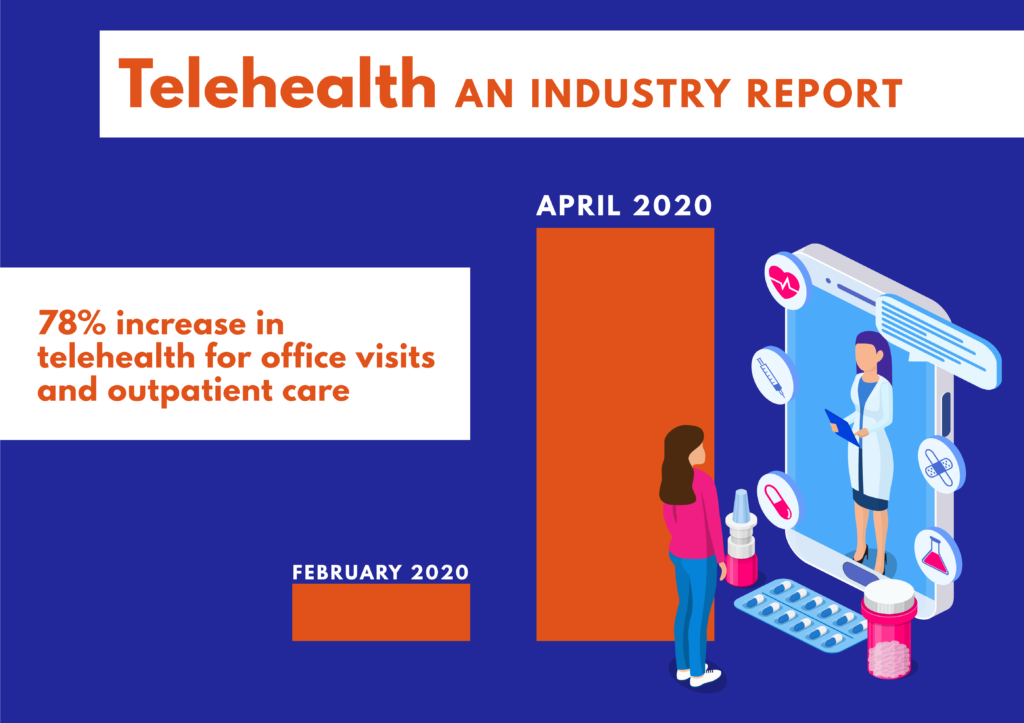
We’ve come a long way in the past few years with regard to telehealth/telemedicine, but technology generally has progressed rapidly. Many of us are old enough to remember dial-up internet in which each new webpage took minutes to load.
Compare that to now, in which internet speeds are lightning quick and available almost anywhere you could go. How many of us would have thought two decades ago that you’d be able to see your doctor in real-time on a screen from your home? Needless to say that the era of telehealth/telemedicine is upon us, and with it comes exciting technology and services that allow telehealth providers to provide comparable healthcare as in-person providers for many conditions and concerns.
In this article, we are going to talk about where the telehealth field currently stands with regard to business and technological aspects. But before we dive into what’s new, let’s catch those new to the field of telehealth on the basics!
- What Is Telehealth?
- What Kinds of Services Can You Get Through Telehealth?
- What Can Be Treated Through Telehealth?
- What Can Health Providers Do Through Telehealth?
- What To Expect at a Telehealth/Telemedicine Visit
- What Are the Advantages to Telehealth?
- Emerging Telehealth Technology
- The Business of Telehealth
- Change and Evolution
What Is Telehealth?

Naturally, a good starting place to learn about the telehealth industry is to set a solid foundation about what exactly we’re talking about when throwing out terms such as telehealth, telemedicine, telecommunication, etc.
Let’s start with the broadest term, which is telecommunication. Telecommunication describes the use of technology to send information, often over large distances, for the purpose of communicating. Simple enough, right? This means that telephones, video conferencing, and other mediums fall under this category. Telehealth is when telecommunications is used to provide healthcare services ranging from monitoring patient health data remotely to patient education to virtual visits with healthcare providers. Telehealth encompasses other terms such as:
- Telemedicine
- Virtual Counseling
- Telepsychiatry
What Kinds of Services Can You Get Through Telehealth?

Before the time of telephones getting access to health specialists could have meant traveling hundreds, if not thousands of miles. Today a wide range of health professionals are taking advantage of technology to provide their patients with care.
According to McKinsey & Company, overall telehealth services were 78 times higher in April 2020 compared with February 2020. Never before have telehealth services been more relevant.
Why are so many health professionals utilizing telehealth platforms? It frankly goes beyond the ability to help increasing numbers of patients. Healthcare providers are utilizing these technologies to increase their income, and these professionals can provide their services while working from home. This is a real advantage for health professionals who have recently had children or need to work from home for various other reasons.
While there are many types of services that can be obtained through telehealth, some will still require an in-person visit. You’re not going to be able to get a root canal through telehealth, but you may be able to obtain a consultation or second opinion.
When talking about telehealth services, you’re going to run across common ones like primary care medical visits, psychiatry and mental health, and counseling services. Maybe some others you haven’t come across, but that are available, such as:
- Telenutrition
- Teleneurology
- Telerehabilitation
- Telecardiology
What Can Be Treated Through Telehealth?
Many common conditions are able to be treated directly through telehealth platforms, and telehealth platforms can be used to make important referrals and allow patients to get second opinions on the diagnosis they have received.
Telehealth platforms and companies sometimes differ on the conditions they are willing to treat virtually, but examples of conditions you’re likely to get help with include:
- Allergies
- Cough
- Back pain
- Headaches
- Heartburn
- Joint pain
- Motion sickness
- Urinary tract infections
- Diabetes
- Hypertension
The list above is by no means exhaustive but may give you a good idea of conditions commonly encountered by telemedicine doctors. Telehealth companies do their best to screen potential patients to ensure they are a good fit for virtual visits. However, sometimes a healthcare provider will explore your medical history and decide that a referral or in-person visit is necessary. If this happens, the telehealth provider will advise you of the next steps that you’ll need to take.
What Can Health Providers Do Through Telehealth?

You may be wondering what healthcare providers can and cannot do through a telehealth platform. The reality is that much of what is done in a traditional doctor’s office can be done or at least organized through a virtual visit. Let’s explain this further.
Doctors and other healthcare providers are able to obtain a detailed history through a virtual visit, which will allow them to formulate likely hypotheses of what is going on in your body or mind. Some conditions may even be diagnosed during the first visit.
To narrow down the list of hypotheses, the healthcare provider may decide to obtain blood labs. Telehealth doctors are able to work with labs in your area, so you won’t have to travel long distances. Sometimes the telehealth platform partners with labs to provide mobile blood draws. With mobile blood draws, a phlebotomist comes to your residence, so you skip the hassle of having to fight traffic to get to the lab. If the telehealth platform provides mobile blood draws, you’ll be given a phone number you’ll need to call to set up a time for the phlebotomist to come to your house.
Once the laboratory analyzes your blood, the report will be sent to your virtual healthcare professional, who will explain the meaning of the labs during a follow-up visit. Sometimes medical imaging is necessary. If imaging is required, the virtual doctor may be able to work with local imaging companies to get you seen and evaluated.
Virtual medical professionals are able to write certain prescription medications without seeing you in person. Prescriptions that may be prohibited by law without an in-person visit include scheduled drugs, which are scheduled and monitored because of their potential for abuse and/or dependence. These drugs include opioids, amphetamines, benzodiazepines, and various other medications. Many medications used to treat common health concerns are not scheduled drugs.
If a prescription is recommended by a virtual health professional, they will be able to order that medication from a pharmacy located near you. Some telehealth platforms even collaborate with virtual pharmacies that are able to ship your medication to your doorstep within days, eliminating the need for you to even leave your house.
Another essential part of a virtual visit is education, in which the health provider explains what they think is going on and why your health concern has developed in the first place. The educational piece of the visit is vital as many chronic and acute health concerns have modifiable lifestyle components, which will help treat your concern and decrease the likelihood the problem will increase in severity.
One aspect of the virtual visit that may be different from an in-person visit is the physical examination. Since the health provider is not physically in the same location as you, they are unable to do things like listening to your heart or lungs. However, the health provider may be able to gather useful physical findings such as noticing bloodshot eyes or gathering the range of motion of certain joints. Blood pressure, which is taken at almost all doctor visits, may or may not be able to be taken depending on whether or not the patient has their own blood pressure monitor.
What To Expect at a Telehealth/Telemedicine Visit

Those new to telehealth or telemedicine may be nervous or at least curious about what these visits typically look like. We’re going to give you the low down.
Telehealth companies have certain conditions they focus on treating. You’ll need to find a company that is willing to treat the health concern you want to get addressed. The next step in the process is getting you set up with a healthcare provider. Some companies allow the patients to select the provider they feel is the best match, while other companies automatically pair the patient up with a provider. Sometimes this process is determined by how quickly you’re looking to get seen by the health professional.
Once you’re matched with the health professional, you’ll be asked to fill out online paperwork, similar to the ones you’d be filling out in person at a doctor’s office. Yes, some things just can’t be avoided, even in this modern-day and age. These forms will likely include privacy and consent to treat forms explaining your rights as a patient and the risks of engaging in a virtual telehealth visit.
The other piece of paperwork you’re likely to come across is a health history form that will ask you to break down your past medical history, current medical history, and family medical history. This form, filled out before the visit, will allow the health provider time to look over your medical history and utilize the virtual visit to ask questions that need clarification.
When your appointment time comes around, you’ll be asked to enter a virtual waiting room for which the instructions for entering will be provided ahead of time. While waiting for the healthcare provider to start the video chat, you may be asked to type answers to questions such as whether or not you have the specific information you’d like to review during the visit.
Once the virtual visit commences, you’re likely to have a familiar experience in which the health provider asks you questions about what brings you in today, gives you hypotheses of what they think is going on, orders labs or imaging that may be necessary, and recommends pharmaceuticals that may be needed to treat your concern. Once the plan is in place to investigate your concern or start treatment, the health provider is likely to set up a follow-up visit to ensure your concerns improve with treatment.
What Are the Advantages to Telehealth?

There are a few obvious and some not so obvious advantages to telehealth. Telehealth allows people to get help with their concerns often more quickly than they can try to get a visit with an in-person provider. This is a major benefit, especially for those who want answers to what they are experiencing as soon as possible.
Individuals who travel frequently and who may be away from home when a health concern pops up are able to see a health provider quickly, without having to go through the hassle of finding an in-person provider willing to take walk-ins. Plus, any medications recommended by the provider can be called into a pharmacy near your hotel or residence while traveling.
If you’re feeling under the weather, probably the last thing you want to do is to travel to a doctor’s office, wait in the lobby, travel to the pharmacy, and then back home again. With telehealth, you’ll skip the traffic and often children screaming in doctor office lobbies by staying in the comfort of your own home.
Maybe the benefit most appreciated by users of telehealth services is the increased amount of time the patient gets talking with the provider. With many in-person health provider visits, you may be lucky to spend 15 minutes with the provider before being handed a prescription and shuffled out the door. Many telehealth service companies are focused on turning this paradigm on its head by building more time with the health provider into their business models.
Telehealth visits may save you both time and money. We already talked about all the time you’re likely to save by avoiding going in person to a doctor’s office, but you may also save money. Many telehealth platforms are competitively priced, and these companies are able to save patients money in their visits by eliminating the overhead of having a physical medical or health facility. While the telehealth platforms do have a cost for operation, they are typically much less than the costs to operate a physical location.
Emerging Telehealth Technology
One of the most exciting parts of telehealth is the new and emerging technology that is being developed to provide better patient care. Sure, telehealth platforms have made massive leaps in the past few decades with video conferencing, text messaging, and electronic form submissions, but the tech world is pushing the boundaries with remote patient monitoring tools.
Remote Patient Monitoring Tools

Many people are becoming increasingly aware of the health tracking functions of the smart technology we wear or carry around daily. Phones and smartwatches now have the capability to monitor step count, track heart rate, and tell us how many hours of sleep you’re getting each night. In fact, some systems even allow you the capability to share your health data with your physician. Now even when you’re going about living your life, important variations and health measures are tracked, which has the potential to aid doctors in diagnosing disorders that may not be readily apparent during the visit.
Technology is making us question the limits of what can be done virtually. A perfect example of this is smart gloves that have technology that can record metrics like the range of motion of joints, allowing physical therapists the ability to track treatment progress and compliance with treatment plans of patients while they’re at home. With this kind of data gathering and monitoring, physical therapists can tweak treatment plans in real-time, ultimately speeding up the recovery process.
Artificial Intelligence (AI) in Healthcare

As much as some of us try to resist it, computers and algorithms are increasingly being incorporated into our daily lives. The truth is that there are some real advantages to leveraging computers to organize and collect data. Artificial intelligence is showing up more and more in medicine generally and telehealth specifically.
This technology is being used to automatically answer simple health questions patients have and educate patients on their health concerns and diagnoses. New technology is making it easy for patients to find and schedule an appointment with their physicians.
Artificial Intelligence is increasingly being used in various forms to diagnose patients’ conditions based on their reported symptoms. It’s clear that we have just begun to explore and utilize the capabilities of artificial intelligence in telehealth.
Integrated Health Information
Both the need and ability to track and monitor health information between health and medical providers has never been greater. Technology is increasingly being utilized to ensure that telemedicine/telehealth providers have access to labs and health records of an individual from other health providers. Before systems that integrated health information, health providers would have to fax a request to other health providers to get records sent to their clinic.
Today, many patients have their health history in their patient portals, which they can share with their telehealth/telemedicine providers. In addition, health providers are also able to view databases of certain controlled-prescription medications to ensure that patients are not getting multiple addictive prescriptions from numerous doctors.
While some of these databases are adopted at the state level, states are increasingly working together to share important health data.
The Business of Telehealth

It’s a good time to be a doctor or owner of a telehealth platform as telehealth is increasingly being accepted as a valuable tool and acceptable substitute for in-person visits for certain health concerns.
Life seems to be moving faster and faster each year with increasing demands on our time, making an in-person doctor’s visit inconvenient and sometimes downright impossible to put on the schedule. Add to this the social isolation that resulted from the COVID pandemic, and it’s easy to see why insurers are increasingly incorporating telehealth visits into their plans.
Investors are also recognizing the role of virtual healthcare companies in solving some of our nation’s most pressing healthcare concerns, which is why they’re hedging large amounts of money on the success of these companies.
Virtual healthcare is a business, which means that this industry must demonstrate value to potential customers and make a profit to continue operating. How are telehealth companies accomplishing these two tasks?
We mentioned earlier that one of the major advantages of many telehealth platforms is the increased time patients get to converse with their doctor. Combine this with the fact that frequently patients get comparable results through virtual visits as they do with in-person visits for common conditions treated through telehealth, and it’s easy to see the value.
Telehealth companies are making it increasingly easy for people to affordably utilize their services. Here are some of the ways they are doing this!
Subscription Plans

Subscription plans may sound like an unusual business plan for telehealth companies to adopt, but these kinds of plans have some serious advantages for both consumers and the business. Many of the subscription plans utilized by telehealth companies involve the user paying a minimal monthly fee paid to the company whether they use the company that month or not. In addition, the consumer is likely to pay a reasonable fee for each visit with a provider.
Subscription plans allow telehealth companies to establish a reliable monthly income necessary to pay for things like EHR’s and administrative staff necessary to run the business. The typically reasonable per visit fee pays for the health practitioner’s time spent in the visit.
If you’re asking yourself, why does this kind of business model make sense for the consumer? It comes down to spreading out costs over time and through the patient network. Instead of going to the ER and walking out with a bill of $400 or your PCP’s office with a $200 charge, you may pay a nominal fee of $10 per month and a $100 telehealth visit. Of course, this is just an example, and the price varies with each telehealth company. This model could make financial sense for individuals who see doctors at least twice per year, and who don’t have insurance or need more frequent visits to address their concerns.
Subscription telehealth plans are adopted frequently by telehealth companies that focus on treating mental health concerns such as anxiety and depression.
In-Network Insurance

Major insurance companies are increasingly contracting with telehealth companies or forming their own telehealth provider network to service their clients. Telehealth/telemedicine has become an increasingly accepted way to receive treatment, and many insurance companies are really paying attention to how they can best serve their members.
Contracting with insurance companies makes a lot of financial sense for telehealth/telemedicine companies as reimbursement by insurance companies for services provided can be close to that received for in-person treatment services. This means that it’s possible for companies to skip some of the overhead costs of running a brick-and-mortar health facility while putting more money into the company and health providers’ pockets.
It’s likely more and more insurance companies are going to get on the telehealth/telemedicine train as this service makes getting health care more accessible.
B-2-B Contracts
Some telehealth/telemedicine contracts haven’t waited around for insurance companies to include their businesses. Telehealth/telemedicine companies are increasingly taking their product offering directly to other businesses.
How does this work? Companies know that finding and maintaining good talent can be one of the most difficult challenges. Companies also know that telehealth/telemedicine services can decrease the time employees are away from work and recognize that offering access to these services is viewed as a significant benefit by current and potential employees.
Often telehealth/telemedicine companies will have a section on their website dedicated to connecting to businesses looking to add telehealth/telemedicine services as their primary form of health coverage to their employees or as an adjunct to the company’s health insurance plan.
Often these B-2-B contracting relationships can be tailored to the company’s specific wants and needs. Companies can contract with telemedicine/telehealth companies for physical health, mental health, or both services for their employees.
The B-2-B contracting pricing will depend on a variety of factors, including the number of employees at the company, services included, and whether or not the company already has an insurance plan for its employees, among other factors. Some companies contract with telehealth/telemedicine companies so that each visit has a copay, while others don’t.
Some telemedicine companies offering B-2-B contracting have set up relationships with independent laboratories to offer special discounting on laboratory services, which can save the companies and the individuals utilizing the telehealth/telemedicine services money.
Change and Evolution
We’d be remiss if we didn’t take a few seconds to point out that the telehealth/telemedicine field is rapidly changing and evolving. This change is occurring at both the federal level with laws delineating what can and cannot be done through a virtual patient encounter, and by companies pushing progress forward by offering new and exciting services and technology.
What’s certain is that the current view of telehealth/telemedicine is going to look and feel radically different in the next few years.
Related:
